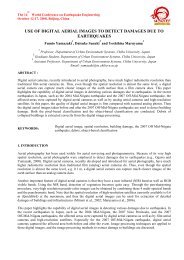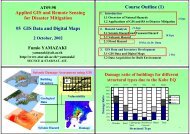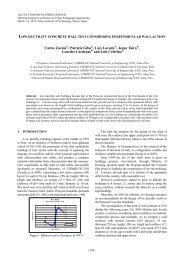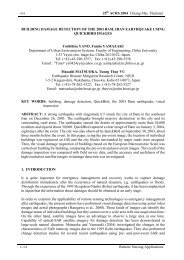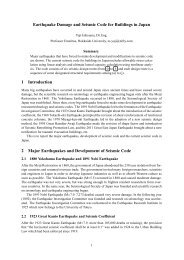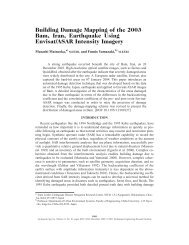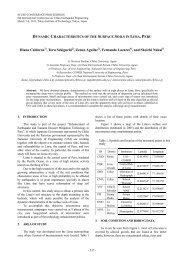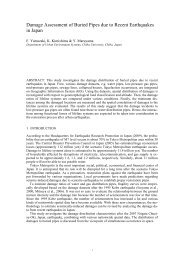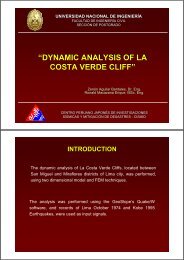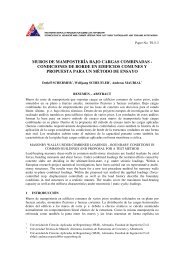Miguel A. Diaz , Koichi Kusunoki , and Akira Tasai
Miguel A. Diaz , Koichi Kusunoki , and Akira Tasai
Miguel A. Diaz , Koichi Kusunoki , and Akira Tasai
You also want an ePaper? Increase the reach of your titles
YUMPU automatically turns print PDFs into web optimized ePapers that Google loves.
espectively. It corresponds to coefficients γ 0.25 <strong>and</strong> 0.12<br />
in Eq. (1), because the hysteretic behavior is quiet close to<br />
the perfect elasto-plastic bilinear model.<br />
The equivalent damping ratio becomes larger using the<br />
equivalent amplitude than using the maximum absolute<br />
amplitude, it is observed in Figure 11. It means that the<br />
equation of the equivalent damping ratio can be estimated<br />
more safely these values using the equivalent amplitude.<br />
In order to compare the experimental <strong>and</strong> estimated<br />
response, the response reduction ratio is calculated from the<br />
shaking table tests <strong>and</strong> formulations. The response is safely<br />
estimated when the actual response reduction ratio<br />
(experimental) is less than or equal to the estimated response<br />
reduction ratio using the formulations presented in this paper,<br />
both mainshock <strong>and</strong> aftershock, whichever is applicable.<br />
F h experimental ≤ F h<br />
estimated<br />
(10)<br />
The comparison between the estimated response<br />
reduction ratio <strong>and</strong> the experimental response reduction ratio<br />
due to mainshocks <strong>and</strong> aftershocks is presented in Figure 12<br />
<strong>and</strong> Figure 13, using Eq. (3) <strong>and</strong> Eq. (4), respectively. These<br />
figures show this comparison using a) the maximum<br />
absolute amplitude <strong>and</strong> b) the equivalent amplitude. Here,<br />
the response safely estimated are represented by points<br />
above the line (y=x).<br />
a) maximum amplitude b) equivalent amplitude<br />
Figure 12 Response reduction ratio by F h , Eq. (3)<br />
a) maximum amplitude b) equivalent amplitude<br />
Figure 13 Response reduction ratio by F h ∗ , Eq. (4)<br />
5. CONCLUSIONS<br />
From the analysis conducted for the experimental <strong>and</strong><br />
estimated results, the following conclusion can be drawn:<br />
o Ten scale three-story steel frames were tested on a<br />
shaking table, seismic performance is determined from<br />
the experimental results <strong>and</strong> compared with the<br />
estimated values.<br />
o The definition of the equivalent amplitude allows<br />
calculating responses where the maximum absolute<br />
amplitude exceeds the elastic spectral response, even<br />
for the specimen which suffered the P-Δ effect.<br />
o The equivalent damping ratio can be more safely<br />
estimated when the equivalent amplitude is defined<br />
instead of the maximum absolute amplitude.<br />
o The formulations estimated safely the equivalent<br />
damping ratio <strong>and</strong> then the response reduction ratio due<br />
to mainshocks <strong>and</strong> aftershocks using the peak<br />
amplitudes to define the equivalent amplitude. The<br />
response reduction ratio is more safely estimated using<br />
Eq. (4) than Eq. (3).<br />
However, this technique would become safer for the<br />
seismic performance estimation if an equation to estimate<br />
the shifting displacement is incorporated.<br />
Acknowledgements:<br />
Authors acknowledge Miho Yamashita, Yuichi Hatanaka, Daiki<br />
Hinata, <strong>and</strong> Yuki Hattori for their great contributions during the tests.<br />
The installation <strong>and</strong> maintenance of the measurement system has<br />
been supported by Mr. Masayuki Araki, Mr. Takamori Ito <strong>and</strong> other<br />
staffs of aLab Co. Also, the authors would like to express their<br />
gratitude to the Japan Science <strong>and</strong> Technology Agency (JST)<br />
through the Science <strong>and</strong> Technology Research Partnership for<br />
Sustainable Development (SATREPS) project “Enhancement of<br />
earthquake <strong>and</strong> tsunami disaster mitigation technology in Peru” for<br />
the fellowship during this research.<br />
References:<br />
Ministry of L<strong>and</strong>, Infrastructure, Transport <strong>and</strong> Tourism (2000).<br />
“Notification No. 1457-6.” Technical St<strong>and</strong>ard for Structural<br />
Calculation of Response <strong>and</strong> Limit Strength of Buildings.<br />
Jennings P. (1968). “Equivalent Viscous Damping for Yielding<br />
Structures.” Proceedings of ASCE, Vol.94, No. 1, 103-116.<br />
<strong>Kusunoki</strong>, K. (2006) “Analytical Study on Estimation of Equivalent<br />
Viscous Damping Ratio for aftershock”, Proceedings of the<br />
Japan Concrete Institute Proceedings of the Japan Concrete<br />
Institute 28(2), 1057-1062.<br />
<strong>Diaz</strong> M., <strong>Kusunoki</strong> K. <strong>and</strong> <strong>Tasai</strong> A. (2012). “Analytical Study of<br />
Residual Seismic Performance by Estimation of Response<br />
Reduction Ratio <strong>and</strong> Equivalent Damping for Aftershocks.”<br />
Proceedings of 15th World Conference on Earthquake<br />
Engineering, Paper ID 1950.<br />
Shibata A. <strong>and</strong> Sozen M. (1976). “The Substitute Structure Method<br />
for Seismic Design in RC.” Proceedings of ASCE, Journal on<br />
Structural Division, Vol. 102, No. 1, 1-18.<br />
ATC-40 (1996). Seismic Evaluation <strong>and</strong> Retrofit of Concrete<br />
Buildings, Report No. SS 96-01, Applied Technology Council.<br />
Shibata A. (2010). “Dynamic Analysis of Earthquake Resistant<br />
Structures”, Tohoku University Press.<br />
<strong>Diaz</strong> M., <strong>Kusunoki</strong> K. <strong>and</strong> <strong>Tasai</strong> A. (2012). “Experimental Study on<br />
Residual Seismic Performance of Scaled Three-Story Steel<br />
Frames Tested on a Shaking Table.” Proceedings of<br />
International Symposium on Earthquake Engineering, 349-356.<br />
- 1210 -





